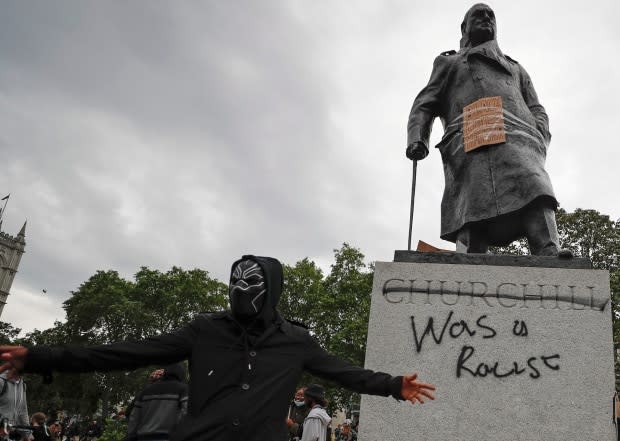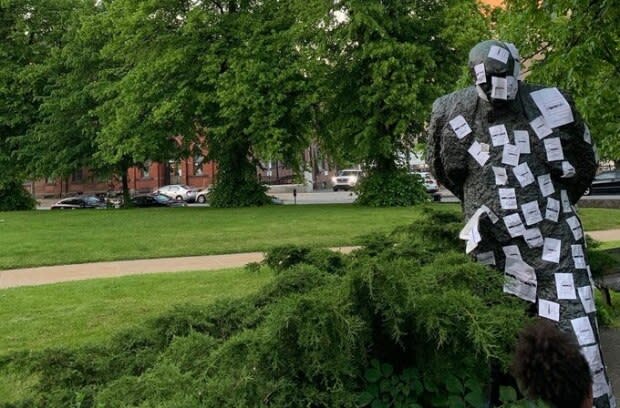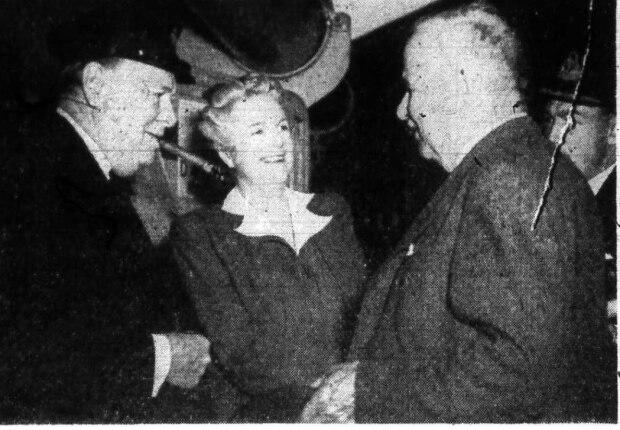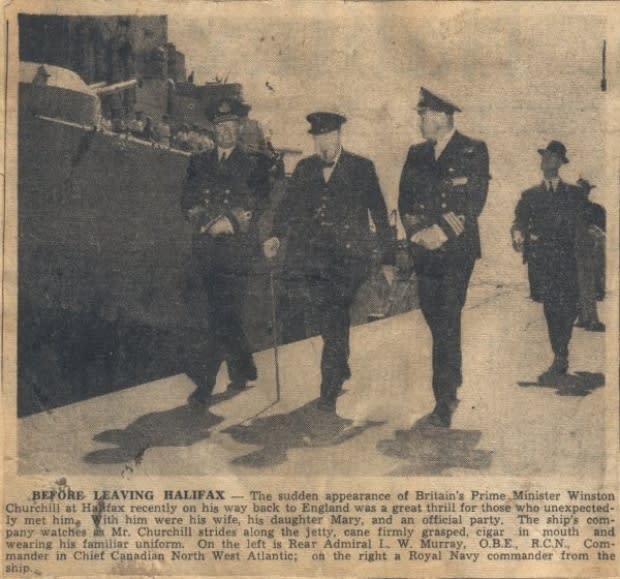A 'Walk against Winston' stirs debate over another Halifax statue
On a fine summer evening, a group of people recently marched up to Halifax's Winston Churchill statue and surrounded it. Slowly, they applied stickers to it until the former First Lord of the Admiralty had been figuratively tarred and feathered.
None of the stickers bore the British prime minister's better-known quotes, such as: "We shall never surrender;" or, "If the British empire and its Commonwealth last for a thousand years, men will still say: This was their finest hour."
Instead, Churchill was quoted as saying: "I'm strongly in favour of using poison gas against uncivilized tribes. It would spread a lively terror;" and "I hate Indians. They are a beastly people with a beastly religion. The famine was their own fault for breeding like rabbits."
The debate over Churchill's legacy — and his statues — has now come to Halifax.

Alex Khasnabish is an anthropology professor at Mount Saint Vincent University. He spoke at the Walk Against Winston, but had a more nuanced take than might be expected.
'An enthusiastic imperialist'
"Churchill is an interesting figure," he said. "I think it's absolutely vital that we honour the memory of people who engaged in the struggle against Nazi Germany and that period of fascism."
Khasnabish's father is from India and he grew up hearing about the 1943 famine in Bengal, where millions died. It was then a British possession and Churchill wouldn't allow food relief to be sent, directing it onward instead to Europe. The "beastly people" quote came from that period.
Despite Churchill's reputation as a freedom fighter, Khasnabish said it was often freedom for a certain type of person. He had no problems crushing anti-British rebellions.
"Churchill in his early life was an enthusiastic imperialist. He participated in many of Britain's wars abroad in putting down popular rebellions against British rule," Khasnabish said. "Churchill has some really awful things to say, frankly, against people who weren't white."
The "poison gas" quote comes from squashing those rebellions, although scholars say he was writing about using something non-lethal, more like tear gas.

It's not the only statue in the city to come under scrutiny. Two years ago, a statue of Edward Cornwallis, Halifax's controversial founder who issued a so-called scalping proclamation that offered a cash bounty to anyone who killed a Mi'kmaw person, was removed from a local park and placed in storage.
While some who were on the recent walk want the Churchill statue to come down, Khasnabish said he's not certain that's the best outcome. "I'm willing to continue to celebrate what I think his myth is meant to celebrate, which is a grass-roots anti-fascist resistance."
Khasnabish said the statue debate points to a deeper societal idea that "great men" define history, rather than the millions of people who actually make movements move. "Those are the stories we need to know about."
He said similar drives turned Martin Luther King and Malcolm X into icons of the Black rights movement, and Gandhi into the hero of Indian independence.
Yet all were humans, and had personal and private failings they wouldn't want stuck to their statues. Khasnabish said turning humans into icons doesn't eradicate their shortcomings.
"If we really want a clear view of where we are now and what we need to change in our society, we have to have an honest accounting of these 'great men' and their role in history."
'A unique accomplishment'

Lee Pollock, a writer and historian, is the former executive director of the International Churchill Society. Yet his perspective on Churchill isn't that different from that of Khasnabish.
"Quite clearly, Churchill had a view of the world that isn't one that comports with how we think about the world today," he said.
Churchill believed that "white, Anglo-Saxon, English-speaking countries and civilizations" had most improved the world, Pollock said, a view many white, Anglo-Saxon Brits and Canadians at the time shared.
"Churchill was wrong about a lot of things," Pollock said. "But against that you have to set a unique accomplishment of being one person at a unique time and place in history who literally changed the world."
Without Churchill in 1940, Pollock said, the Nazi swastika could well have flown across Europe. Without Churchill, the U.K. may have settled with Hitler, and the U.S. might have stayed out of the war or entered too late to change the outcome, he said.
Pollock said controversies over Churchill statues are strongest in Canada and the U.K. The U.S. focuses on American figures. "It's a legitimate question to raise, and I think there are ways to answer it without tearing Winston Churchill off his literal pedestal, if not his figurative one."

Apart from the man it represents, Halifax's Churchill statue raises other questions. Was it an original work of art commissioned for the city? Or was it a surplus statue bought on the cheap? Both theories have their adherents.
The truth is Halifax's Churchill statue started with a man named Leonard Kitz, who in 1955 had become Halifax's first Jewish mayor. In the 1970s, Kitz, a veteran of the Second World War, collected private donations to pay for a Churchill statue.
Newspapers reported on the statue's progress from England, where it was delayed by striking workers, to its grand unveiling in front of the old Halifax library on Jan. 20, 1980.
Sculptor lost family to the Holocaust
The three-metre tall, 1.5-tonne bronze statue shows Churchill wearing a three-piece suit and bow tie, left foot stepping ahead, hands clasped behind his back.
Oscar Nemon created it. Nemon was Jewish, and most of his family died in the Holocaust. Admirers of Nemon's work saw his deep personal grief and hope for a better future etched into his busts and sculptures of Churchill.
Nemon described Churchill as a "bellicose, challenging, and deliberately provocative" person and said he wanted his sculptures to be biographies set in bronze. Churchill found Nemon compelling, too, and once created a sculpture of the sculptor.
Nemon created many busts and sculptures of Churchill, but no others look quite like Halifax's.

So was the striding statue based on a photograph from a Halifax visit?
Churchill stopped in Halifax in August 1943. It was part of a trip to meet with allies, but he also visited Citadel Hill and took in the view.
Halifax Daily Star reporter R.D. Palk reported that only railway workers, clerks and "women cleaners in slacks" saw Churchill during that clandestine visit.
"He turned to the small gathering and gave the V salute, bringing a spontaneous burst of applause from the group," Palk wrote in September 1943.
The accompanying photo shows him smoking a cigar and talking to premier A.S. MacMillan. Another photo shows Churchill striding along the Halifax dockyard, left foot forward, but he's holding a cane.
Churchill visited Halifax again in February 1944. Some 1,500 Haligonians lined up to see Churchill and cheered as he stood on the rear platform of his train, rolling a cigar in one hand.
He urged them to come closer and soon they were serenading him with the war-time classic, It's a Long Way to Tipperary. He asked to hear O Canada, and they obliged. A photo shows him smiling and pointing something out to his wife.

The evidence suggests that Halifax's Churchill statue is a unique creation, unmatched elsewhere, and while it may have been inspired by photos of his wartime visit, it largely came out of its creator, inspired by his own memories of Churchill.
Churchill died in 1965.
MORE TOP STORIES

